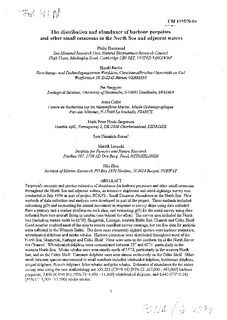| dc.description.abstract | To provide accurate and precise estimates of abundance for harbour porpoises and other small cetaceans
throughout the North Sea and adjacent waters, an intensive shipboard and aerial sightings survey was
conducted in July 1994 as part of project SCANS - Small Cetacean Abundance in the North Sea. New
methods of data collection and analysis were developed as part of the project. These methods included
estimating g(0) and accounting for animal movement in response to survey ships using data collected
from a primary and a tracker platform on each ship, and estimating g(0) for the aerial survey using data
collected from two aircraft flying in tandem (one behind the other). The survey area included the North
Sea (including waters north to 62°N), Skagerrak, Kattegat, western Baltic Sea, Channel and Celtic Shelf
Good weather enabled most of the area to receive excellent survey coverage, but too few data for analysis
were collected in the Western Baltic. The three most commonly sighted species were harbour porpoises,
whitebeaked dolphins and minke whales. Harbour porpoises were distributed throughout most of the
North Sea, Skagerrak, Kattegat and Celtic Shelf. None were seen in the southern tip of the North Sea or
the Channel. Whitebeaked dolphins were concentrated between 55° and 60°N, particularly in the
western North Sea. Minke whales were seen mostly north of 55°N, particularly in the western North
Sea, and on the Celtic Shelf. Common dolphins were seen almost exclusively on the Celtic Shelf. Other
small cetacean species encountered in small numbers included whitesided dolphins, bottlenose dolphins,
striped dolphins, Risso's dolphins, killer whales and pilot whales. Estimates of abundance for the entire
survey area using the new methodology are 352,523 (CV=0.14) [95% Cl: 267,000- 465,000] harbour
porpoises, 7,856 (CV=0.30) [95% Cl: 4,000- 13,300] whitebeaked dolphins, and 8,445 (CV=0.24)
[95% Cl: 5,000- 13,500] minke whales. | no_NO |
